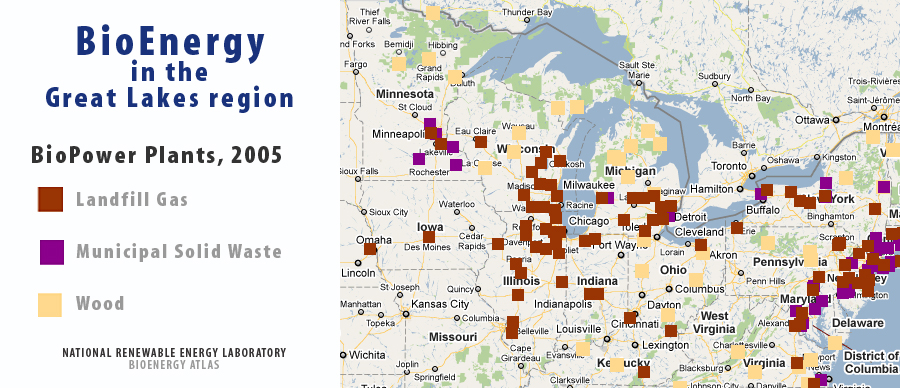
Biopowers plants, along with plants that produce biofuels (not pictured), account for about half of sustainable energy efforts in Great Lakes states. Click to enlarge.
More and more bioenergy plants are fueling sustainable energy efforts in Great Lakes states, according to a National Renewable Energy Laboratory BioFuels interactive map.
Biofuels and biopower plants, which produce energy from landfill gas, wood and municipal solid wastes, roughly equal the number of power plants run on wind and water, according to the mashup.
More than 50 plants in Wisconsin, Illinois and southern Michigan run on gas produced by microorganisms that break down landfill material.
Northern Minnesota, Wisconsin, Michigan and Ohio each have a handful of biopower plants fueled by wood. And about a dozen Minnesota, Michigan and Indiana plants convert municipal solid waste into ethanol.
The atlas also illustrates biopower feedstocks, such as crop residues and methane resources, and non-biopower power plants for comparison.
The mashup’s counterpart, BioPower, provides additional information on biomass facilities and sources, wind and solar energy resources and alternative fueling stations.
The BioPower map shows that extracting methane from wastewater is more common in larger cities like Chicago, Detroit and Minneapolis-St. Paul.
The query tool is handy for gathering data at certain locations, which can be downloaded from the site in a database.
The two maps, which make up the laboratory’s BioEnery Atlas, combine data from the U.S. Department of Energy, Environmental Protection Agency and Department of Agriculture.
Biofuels is an interesting option for the energy mix, but haven’t the advocates of burning biofuels heard of “global warming” and “greenhouse gases” – what do you think happens when you burn trees??? You can say “it’s better than burning oil” but I don’t see much more benefit to chopping down the trees that were working together to make the forest act as carbon sponges/reservoirs, and then releasing carbon in several forms (including CO2) into the atmosphere when it gets burned. Maybe we should consider finding ways to supply our energy that don’t release excess CO2 into the atmosphere!
What a waste that our forests are being clear-cut to supply these wood burning plants. Is that why the Michigan DNR is now allowing so much clear-cutting of state forest land? Don’t they employ any biologists that know how destructive that practice is to forest dwelling birds and other creatures? It’s also downright ugly–at a time when our forests were FINALLY starting to recover from the lumberbaron days. Politics above principle, I guess.